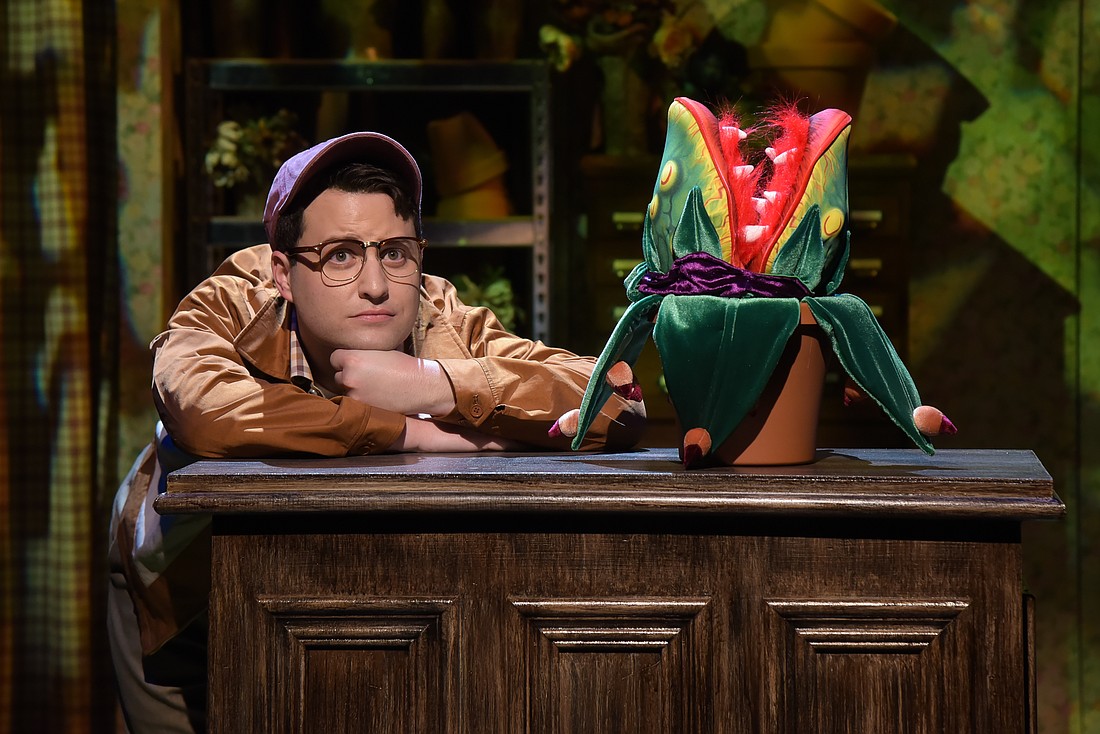- July 26, 2024
-
-
Loading

Loading

Alan Menken and Howard Ashman’s “Little Shop of Horrors” explores the seductive machinations of Audrey II — a carnivorous plant from beyond the stars who seduces a good-natured nerd named Seymour into feeding her a steady diet of lousy bosses and sadistic dentists. The musical is “Dr. Faustus” for the 1950s, and a star-crossed love story, to boot. But it’s also an astronomical acting challenge.
W.C. Fields famously said that you should never co-star with children or dogs. Based on “Little Shop of Horrors,” he could have added talking plants to the list. Audrey II is the musical’s most dynamic personality— a trash-talking, carnivorous plant. This verbose vegetable takes the stage in Florida Studio Theatre’s latest production.
As there are no carnivorous plants in Actors Equity, Audrey II comes to life with a mix of puppetry and voiceover acting. In FST’s production, Derrick Cobey gives the vegetable a voice; puppeteer David Gaztambide creates the illusion of life. The puppets he works with are made of high-density foam, printed Spandex fabric and cast-rubber teeth. Lifeless on their own. But he makes them move and groove.
Three-week rehearsals began in late October. As Audrey II grows, Gaztambide animated four different puppets in increasing sizes; Cobey simultaneous speaks Audrey II’s dialogue. They synchronized word and action throughout the process. That’s because they could see each other. But that’s not the way it works on stage. Before the curtain goes up, they have to get it together. According to director Sean Daniels, they have.
“I’m impressed with their collaboration,” he says. “They seamlessly work together, share thoughts and discuss intentions. You forget that David is in the puppet mouthing Derrick’s words. They’re really on the same page in the moment.”
To both puppeteer and performer, it’s not a technical process. Both agree: it’s all about characterization. What’s their take on Audrey II’s character?
Cobey describes her as a master of mental chess.
“Audrey II is constantly changing,” he says. “She’s chaotic at times, but she’s always trying new tactics. She’s a classic manipulator who’s constantly enticing Seymour to get her way without scaring him off. She’s subtle at times — so I can’t always dial it up to 11. Exploring Audrey’s different facets and emotions has been fun.”
Cobey translates Audrey II’s mind games to spoken dialogue. Gaztambide translates that spoken-word performance to the puppet’s movements.

“At times, Audrey tries for an emotional appeal like a big, green puppy. David puts that endearing quality in his voice, so I’ll reflect that by tilting Audrey’s head. At other times, he gives her a snakelike quality, and puts vibrato and hisses in her words. He’s brilliant at that. I translate that by making the puppet slither and slide. Those are just two examples. During rehearsals, we constantly communicate.”
Once the curtain goes up, all communication goes down. On stage, puppeteer and performer must have their act together — because there’s no other choice. It’s just the way “Little Shop of Horrors” works.
In the FST mainstage production, Cobey’s live voiceover performance is out of sight, but not out of mind. He’ll be loud and clear on the FST sound system; he’ll be nowhere to be seen on stage.
You can’t see or hear Gaztambide at all. He starts hunkered down below a table working a small, cute Audrey II hand puppet. In the final act, he’s literally inside a giant Audrey II who’s hungry to take over the world.
“That’s a lot of fun,” he says. “But I’m bent over and twisted around inside a big, hot puppet doing the lip-synch with Audrey’s flapping lips. By the time they pull the plant off of me, everyone’s asking, ‘Are you OK? Are you hot? Do you need anything?’ It’s a physical challenge at times.”
According to director Daniels, the challenge will be worth it.
“I love ‘Little Shop of Horrors’ and keep coming back to it,” he says. “It’s some of the best musical writing ever. It’s charming, joyful, funny, and never campy. Characters like Seymour are all facing relatable problems.
"How far should I go? Working with a carnivorous plant from outer space might be my only shot. Should I take it? Derrick and David’s brilliant collaboration is a big reason you care about these characters. They’ve truly fleshed out who Audrey II is — and make you understand what’s at stake when Seymour and Audrey interact with her.”